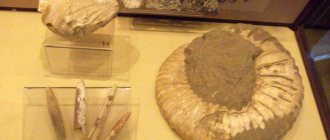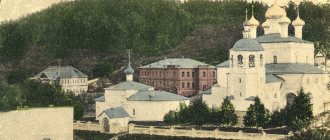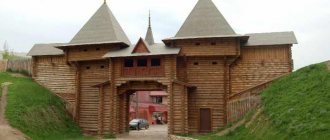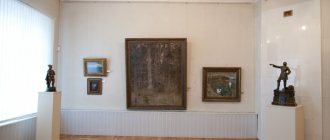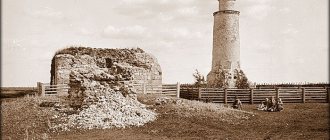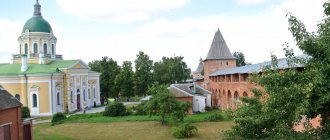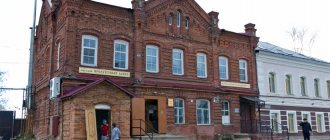Where is
The Samovar Museum in Kasimov was opened in honor of the 850th anniversary of the city. Its exhibition includes more than 500 exhibits. The exhibitions are dedicated to demonstrating the traditions of Russian tea drinking. The museum's rare items include unique items, such as Kolchak's samovar or the samovar given to Brezhnev.
Kasimov is a city of administrative significance, located in the central part of the East European Plain, closer to the northeast of the Ryazan region. Kasimov is separated from Ryazan by 165 km. To get to the Nizhny Novgorod or Vladimir regions, you need to travel about 30 km.
Samovar Museum in Kasimov
The city was built on the banks of the Oka River, on the north side of the city there is a famous biosphere reserve of national importance. The population of Kasimov is about 30 thousand people. Mostly Russians and Tatars live here. The city is connected to Moscow by a direct road, the route is designated “P 105”. In addition, the road is often called “Egoryevskoe Highway”.
Bus routes run through the city, connecting the settlement not only with Moscow, but also with Ryazan, Murom, as well as Nizhny Novgorod and Vladimir.
Additional ways to get to the city:
- By rail. The railway station of the same name is located 7 km from the city center. Bus routes from the urban village of Shilovo arrive at the station.
- On a boat. Cruise ships often stop in Kasimov. One of the popular river routes is called “Moscow Around the World”.
The Samovar Museum in Kasimov is located at: st. Sovetskaya, 4.
Borshchev Collection
The extensive collection includes about five hundred copies. Most are antique; in addition to those made in Russia, you can see foreign products here. The exhibition presents products from all Russian factories, as well as samples created in Vienna, Warsaw and London. In addition to the samovars themselves, here you can look at bouillottes, other kitchen utensils, and serving items. Geographically, the collection is located near Tula, on the territory of the Gurmant Hotel; in the near future it is planned to build a separate building for it.
History of appearance
The Kasimov Museum appeared in 2007. The private collection of Mikhail Silkov became the basis for creating and combining exhibitions.
Brief description of the Russian Samovar Museum:
- there are more than 500 exhibits;
- there are rare specimens;
- thematic exhibitions have been created demonstrating the traditions of Russian tea drinking over the past 400 years;
- 4 exhibition halls;
- several types of excursions.
The first item in Mikhail Silakov’s collection was a copper samovar, produced in 1778. The samovar was created at the famous Tula factory. At first it belonged to Nazar Lisitsyn, and then moved to his relatives. In 1991, the samovar was put up for auction as one of the rare items of the 18th century.
The Russian Samovar Museum in Kasimov was opened in honor of the city’s 850th anniversary. The project involved funds from private investors. A team of partners led by Mikhail Silakov found the premises and organized space for exhibitions.
In addition, a store was opened at the entrance where they sell modern samovars. Anyone can choose a samovar according to size and shape, buy it and take it with them.
Collecting items for the museum, according to the owner, included several stages. Due to the fact that one of the surges in the acquisition of samovars occurred in the sixties of the 20th century, Silakov was able to acquire items in good condition, which required minor restoration.
The fact is that during the time of N.S. Khrushchev, the fashion for buying samovars again spread among townspeople. Many families owned samovars of different sizes, intended for morning or evening tea.
Then household items, which were gradually replaced by teapots, turned out to be unnecessary to anyone. Silakov says that he found samovars at scrap metal collection points, in abandoned village houses, and restored them after being found in landfills.
By 2000, Mikhail Silakov found and bought many copies from the population. As a result, the collection reached 400 pieces. For storage, a separate warehouse was required, which Mikhail rented. But even then, he didn't think about opening a showroom.
Mikhail Silakov’s relatives told how the idea of the discovery came to him. One day he was walking around his hometown and met a group of tourists in the old part on Sovetskaya Street. Silakov unwittingly overheard the conversation that the tourists were having among themselves. They said that in the city included in the Golden Ring of Russia route there are surprisingly few museums or exhibitions that one would like to visit.
By that time, the collector had accumulated enough exhibits. He decided to share his collection with other people. It took more than 3 years to implement this plan. Silakov emphasized that he was going to exhibit all the exhibits that he owned. Some of the specimens were interesting for their appearance, while others became famous because of the famous manufacturer.
But there are also those that have become part of history because they belonged to famous people. After the opening of the museum, “famous” samovars appeared on display. Among the exhibits there are still handmade devices that belonged to Nicholas II, Sergei Yesenin, and Leo Tolstoy.
Museum visitors are given a unique opportunity to see samovars of different shapes and sizes. The variety of materials used as a base and the addition of finishing details amazes the imagination.
Lobanov Collection
This collection is considered one of the largest in the world. The insurance amount at which the exposition was estimated is impressive: it is about $10 million. The number of exhibits is more than two hundred; a significant number of related items are presented here: kitchen utensils, antique furnishings and other items related to tea drinking. The collection has been collected for more than fifty years by the third generation of Lobanovs. A special feature of the exhibition is the uniqueness of each of the exhibits: any samovar from the collection has its own amazing history. The collection is not a museum in the literal sense of the word: it often moves from place to place, and exhibits participate in various exhibitions. Negotiations are currently underway to create a full-fledged museum on the basis of this private collection.
Architecture
The Kasimov Samovar Museum is located in a two-story building on Sovetskaya Street. Almost all the buildings in this area are mansions built at the beginning of the 19th century. Initially they were painted with ocher pigment.
During the restoration, the style and architecture were preserved. The quarter belongs to the center of the old part of the city, at the end of the street is the Ascension Cathedral.
Internal organization
The museum is stylized as antique.
In addition to the main exhibits that are exhibited in the halls, here you can see various household items or furniture produced in the 18th-19th centuries:
- chests of drawers with carved handles;
- cabinets for storing dishes made of oak;
- the first cast iron egg boiler;
- iron heated by coals;
- textiles that were used in the interior;
- chairs and tables with lacquered surface.
The samovar museum in Kasimov has 400-500 copies. The data varies due to the fact that some experts count not only samovars, but also other household items collected during collecting.
"Tula samovars"
The very first Russian samovars began to be produced in Tule. It is not surprising that this city is home to one of the most significant museums dedicated to the samovar. It opened in 1990; the exhibits on display clearly illustrate the history and process of evolution of Russian samovars. The museum's exposition includes more than three hundred exhibits, here you can see one of the first Russian samovars, modern models, a 70-liter pantry and a small souvenir samovar with a volume of one teaspoon. It is not possible to boil water in some samovars: they are decorative and made from a variety of materials: wicker, wood, clay, glass and even sugar.
Museum expositions
There are 4 exhibition halls for the maintenance and storage of collectible items. At the entrance to the museum, visitors are greeted by a pyramid of 26 samovars. On tiers draped with textiles, there are samovars of different shapes and sizes. As an accompaniment, plaques are attached with a brief description telling the history of each specimen.
Before viewing the exhibition, visitors are invited to familiarize themselves with information about the classification of samovars.
| Criteria | Description |
| By material type | Brass, silver, copper, metal alloys. |
| To size | From 1 glass to 48-50 l. |
| By type of fuel used | Wood-burning, electric, coal. |
For products working with firewood or coal, there is a special tray where the ignition material is placed. In the 20th century Electric samovars have become especially in demand.
The heating system was located on the bottom of the case, and in the rear there was a socket for attaching a cord. The heating system rarely failed, but if necessary it could be replaced with new elements.
The exhibition halls are conventionally divided into sections. The tea party room is one of the most sought-after and popular rooms. Here they sell figured gingerbread cookies covered with glaze. The sweets are made in the Ryazan region and delivered to the museum at opening time.
Contents of the exhibition in the tea drinking area:
- a samovar designed for one person is called “Egoist” and holds 250 ml of boiling water;
- samovar for 2-3 people, called “Tete-a-tete”;
- “Family samovar”, holding 1 bucket of water.
All items are lined up so that visitors have the opportunity to estimate their size.
Another interesting exhibition demonstrates samovars by type of use. Not everyone knows that you can heat soup or porridge in a samovar. Most often it is used to heat boiling water.
The device intended for heating soup or porridge is made of heavy metals. It warms up slowly, but retains heat longer. Samovars with thin walls are designed for boiling water for further preparation of tea.
In the next room, visitors are invited to look at a cross-section of the samovar. Immediately after this, interested visitors have the opportunity to purchase a samovar at a local souvenir shop. For sale are working specimens made of durable materials using electric heating.
For those interested in unusual samovars, an exhibition has been created with objects of different shapes and types of heating. The most famous of them: “glass”, “ball”, “pear”, “vase”, “jar”. Each instance has its own characteristics.
Many collectible items were created by hand, craftsmen came up with monograms, developed the smallest details and installed unusual structures for turning the tap. The nuances can only be seen upon closer inspection.
In the next room there is an exhibition that demonstrates the largest samovar, it holds 48 liters. The item was sold by the trading house of the Shemarin brothers for the Orenburg prison. There it stood until 1900 in the prisoners' dining room.
In addition to the largest samovar, the exhibition displays a camping samovar, that is, a samovar lit with a boot. The tradition of kindling arose during population movements from one area to another. Families had to leave their home, they took with them everything they could take.
During the journey, samovars were blown up everywhere at stops so that family members could drink hot tea at a halt.
The third room houses the most valuable specimens. They are made of silver, trimmed with gold. Some exhibits are fenced off from curious visitors with glass display cases to protect them from theft and damage. Unique specimens are also presented here.
Excursions
To appreciate the collection, visitors are offered the services of guides who tell in detail the history of each specimen.
Excursion services:
- individual excursion – 300 rub. (excluding entrance fees);
- for a group of 10 people or more, the cost of the excursion will be reduced to 200 rubles. per group.
In addition to the traditional tour, which introduces the features of each exhibition hall, you can book a tour with an additional tea party. A visit to the teahouse built at the museum offers the opportunity to buy a delicious cake for tea, try tea with pancakes, gingerbread cookies or sweets.
Museum in Kasimov
The exhibition includes more than 400 items; the museum opened nine years ago. The collection presents mainly Russian samovars of all possible shapes: jar, glass, acorn, pear, egg, vase, ball. The exhibits on display were made by craftsmen from all over Russia, some of which are very rare. Visitors to the museum, in addition to the impressive exhibition, note interestingly organized excursions that end with tea. The collection of samovars is complemented by accompanying exhibits and kitchen utensils, allowing you to immerse yourself in the world of traditional Russian life.
Interesting Facts
The museum employs people who treat the traditions of Russian tea drinking with special reverence. The guides try to tell as much interesting information as possible about each exhibit of the museum. First of all, they talk about how the samovar works.
It consists of several parts:
- body;
- cavity for fuel;
- a special tray to which the legs are attached;
- neck as a transition between the main body and the pallet;
- handles with wooden inserts;
- a faucet or spout with a turning mechanism that, when turned, releases a stream of hot water.
In the museum you can see a cross-section of a samovar.
During the tour, many interesting facts are announced:
- the country's acquaintance with the tea drink took place in the second half of the 18th century;
- the decoration of samovar bodies largely depended on the fashion trends of the time; the body was decorated with monograms, inscriptions were created and patterns were placed;
- samovars became an indispensable element of household appliances in the 18th century;
- Researchers consider the Ural territories to be the birthplace of samovars, where factories first began to produce classic samovars of the traditional type;
- The first mention of the samovar dates back to 1740; historians found it in the customs books of Orenburg.
The exhibition of the Kasimov Museum contains unique specimens, for example, a samovar in the shape of a steam locomotive of the Demidov brothers. The brothers were the founders of a samovar factory.
The collection includes porcelain samovars, which are called “moths”. They are made from high quality porcelain. The nose is additionally decorated with curls.
The guides dwell in detail on the description of the life of Russian people who use samovars. It is known that objects were rubbed with special care before various holidays. Sand and stones were used for rubbing; they were used to remove scale from the body.
For some time, families liked to tell fortunes by the noise of the samovar. At certain periods they especially listened to him. The sounds of boiling water could be seen as a promise of family well-being, monetary gain, or impending disaster.
The museum staff note that they especially like to conduct school excursions. Primary school students pay attention to the exhibit, which is called a samovar that “fulfills wishes.” It was made by the master for his daughter when she got married.
According to stories collected by Ivan Parfilyevich Elagin, the samovar could fulfill the simplest desires if you rubbed its body with your palm. The legend is confirmed by the fact that on the body of the samovar the sides are rubbed to a shine.
For Russian people, the samovar has become one of the attributes of hospitality. This item has united people around the same table for many centuries. Thanks to the production of samovars, establishments such as tea houses appeared in Rus'. There the samovar stood on a special stand and was periodically filled with water.
Most teahouses adopted a self-service system as a basis. Each visitor could go to the samovar and pour boiling water into a glass.
In the second half of 2014, Mikhail Silakov implemented another idea. He opened a museum of bells, which he collected for several years. Today Kasimov has become one of the most interesting points on the tourist route. The Russian Samovar Museum is known throughout the country; it does not need additional advertising. People come from different cities of the country to see the unique samovars.
